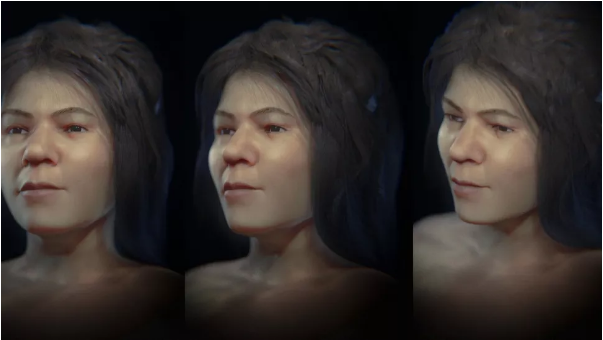
Archaeologists have reconstructed the face of a Paleolithic woman whose human skull was found buried inside a cave in 1881 in the hamlet of Mlade located in today’s Czech Republic. The subject was identified as male at the time, and the skull was determined to be from around thirty-one thousand years ago.
The so-called Mlade 1 skull, which was misidentified more than 140 years ago, really belonged to a seventeen-year-old female who lived during the Aurignacian, a period in the Upper Paleolithic (roughly 43,000 to 26,000 years ago).
The team described how they categorized the sex of “one of the oldest Homo sapiens found in Europe” in a new online publication titled “The Forensic Facial Approach to the Skull Mladec.”
Brazilian graphics specialist Cicero Moraes, who is also one of the book’s co-authors, explained to Live Science through email that “when the skull was analyzed individually, the features pointed to a male. But when later studies compared the skull with others found at the site, the evidence pointed to a female.”
Computer Tomography Scans Used to Create Digitized Approximation
Moraes and co-authors Ji indelá, a surveyor with local surveying firm GEO-CZ, and Karel Drbal, deputy director of the Cave Administration of the Czech Republic, used CT (computer tomography) scans to create a digitized approximation of the skull using data from the 19th-century archeological dig. Forensic facial reconstructions were also carried out by researchers in the 1930s, but these were constrained by a lack of technology.
In order to fill in the gaps of what this person would have looked like, Moraes turned to the information already available about contemporary human jaws since the mandible (lower jaw) was absent.
Moraes said, “We had to reconstruct the skull and…we used statistical data of average and projections extracted from about 200 CT scans of modern humans and from archeological excavations belonging to different population groups, including Europeans, Africans and Asians.”
He added that, “This allowed us to project missing regions of the human face.”
He employed “a series of soft-tissue thickness markers that were spread across it” after creating a comprehensive digital scan of the skull.
Moraes said, “These markers, roughly speaking, tell the boundaries of the skin in some regions of the face. Although these markers come from statistical data extracted from living individuals, they do not cover the entire face and do not inform the size of the nose, mouth and eyes, for example.”
Researchers “imported CT scans of live subjects and deformed the bones and soft tissue from the CT scan to match the face being approximated” in order to supplement the data.
Moraes also said, “In the case of the Mladeč 1 fossil, we deformed two CT scans, one of a man and one of a woman, and the two converged to a very similar result.”
Two Digital Simulations of Paleolithic Woman’s Potential Appearance
Moraes produced two digital simulations of the person’s potential appearance for the book, but when it came to the person’s expression, he chose the path of caution.
Moraes said, “We chose to generate the neutral face by tradition, as we are used to presenting works to specialists. The trend will now be to present two approaches to the works, one more scientific and simple in grey scale, with eyes closed and without hair and the other more subjective where we generate a colored face with fur and hair.”
Archaeologists occasionally reclassify the sex of human remains. However, this is not particularly often. Moraes cited the fossilized skeleton known as the “Zuzu” from Brazil as an illustration.
He said, “That case was different; initially it was thought to be a woman, but later studies revealed it was actually a male.”
The original dig at the Stone Age burial site also uncovered stone tools, bone tips, and many teeth in addition to the skull. Little is known, however, about the young lady who was buried there.
See all the latest news from Greece and the world at Greekreporter.com. Contact our newsroom to report an update or send your story, photos and videos. Follow GR on Google News and subscribe here to our daily email!



